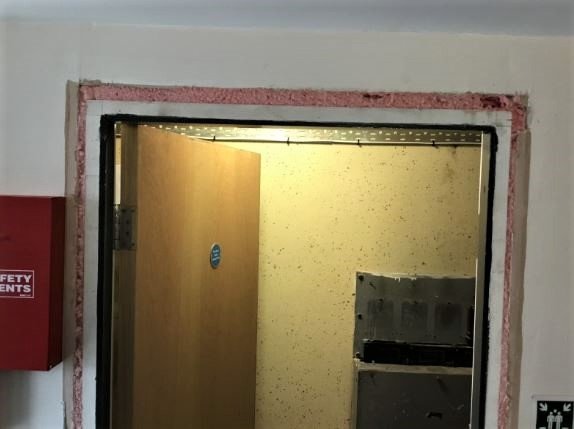A litany of fire door failures in both residential and commercial properties have been documented by a leading buildings surveyor.
To mark the recent Fire Door Safety Week, two surveyors from Trident Building Consultancy catalogued the most common fire door defects encountered during post-Grenfell remediation projects where cladding was replaced and fire risk assessments updated.
One project featuring multiple residential tower blocks sampled seven fire doors per block. Architraves were removed so the surveyor could assess detailing between the door frame and structural opening.
The intrusive survey found that the door frame installations did not measure up against requirements of fire test evidence and wouldn’t provide the required period of fire resistance. All fire doors and frames consequently had to be replaced.
“Every single one of the sample fire doors we inspected was non-compliant.” Christian Watkins, Trident

“It was shocking to see that every single one of the sample fire doors we inspected was non-compliant,” said Christian Watkins, an assistant building surveyor at Trident who worked on the project. “Once the architrave was removed, we could see the back of the door frame was packed with pink foam.
“This wasn’t going to act as any sort of barrier and clearly wasn’t in accordance with the test evidence for the fire doors. These buildings were only refurbished in 2015.”
Watkins and Trident executive director Matt Clare also frequently noted the following problems:
- Lack of maintenance records
- Missing or painted intumescent seals, which compromises fire resistance
- Fanlight windows above doors being replaced with plywood, which doesn’t offer the fire resistance needed
- Integrated ventilation grills without any fire resisting properties
- Gaps between the door and the door frame are often excessive
- Missing or incorrect fire escape signage
- Locked fire doors
- Additional untested ironmongery installations
- Door closers not performing as intended
Matt Clare, one of the specialist advisers on the Steering Group on Competence for Building a Safer Future and its working group looking at the skills and training requirements for fire risk assessments, said:
“Design and build is partly to blame. It is absolutely clear to me that such contracts and procurement routes, where risk in construction contracts is being shifted onto the contractors, has driven the wrong behaviours when it comes to building safety.
Clerk of works
“I think that the loss of the clerk of works from construction is another factor. There are things being done that you would never have got away with in a traditionally procured contract because the clerk of works would have told you to take it down and do it again. That doesn’t happen anymore.
“But there’s also an overall decline in standards of workmanship and care and pride when it comes to our buildings. And that’s the very pernicious attitude we need to change fastest, across all trades and professions.”
Trident has called for clerks of works to be reinstated as the norm. It referenced one of its recent projects – a new build care home in Scarborough – and praised how the clerk of works on that site oversaw the installation of fire doors.
Christian Watkins said: “I inspected the development during the plastering stage when the fire doors were also being installed. It was interesting to note that the carpenters were fitting the doors extremely tight into the frame. This was to allow for the timber shrinkage that occurs when heating is applied to the building and the plaster finishes dry out.
“Once the moisture levels had stabilised, final adjustments were made to the doors. This approach ensured that gaps between the door, frame and threshold didn’t shrink and then exceed the maximum acceptable standards. I’ve never seen that method being used before and it prevented anyone having to go back and rectify the doors post-build.”
In addition to having a clerk of works on new build projects, Trident has given its strongest support to the idea of a compulsory competency register for fire door installers, in line with the recommendations in the Raising the Bar report.
Trident recommends to all its clients that only complete fire door sets are specified, tested through a third-party certification scheme such as BWF-CERTIFIRE, which provides full traceability.
Matt Clare said: “It is our responsibility both as property owners and construction professionals to ensure that we are prioritising fire safety throughout a building’s life. Properly specified, fitted and maintained fire doors are a fundamental part of this.”
2023 Fire Safety eBook – Grab your free copy!
Download the Fire Safety in 2023 eBook, keeping you up to date with the biggest news and prosecution stories from around the industry. Chapters include important updates such as the Fire Safety (England) Regulations 2022 and an overview of the new British Standard for the digital management of fire safety information.
Plus, we explore the growing risks of lithium-ion battery fires and hear from experts in disability evacuation and social housing.